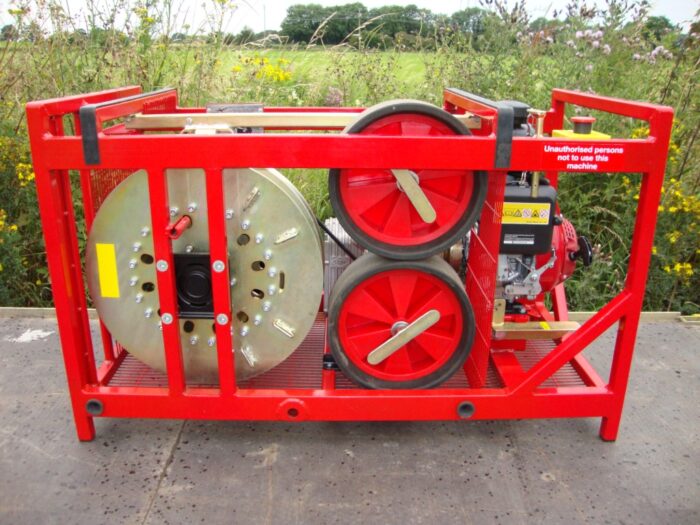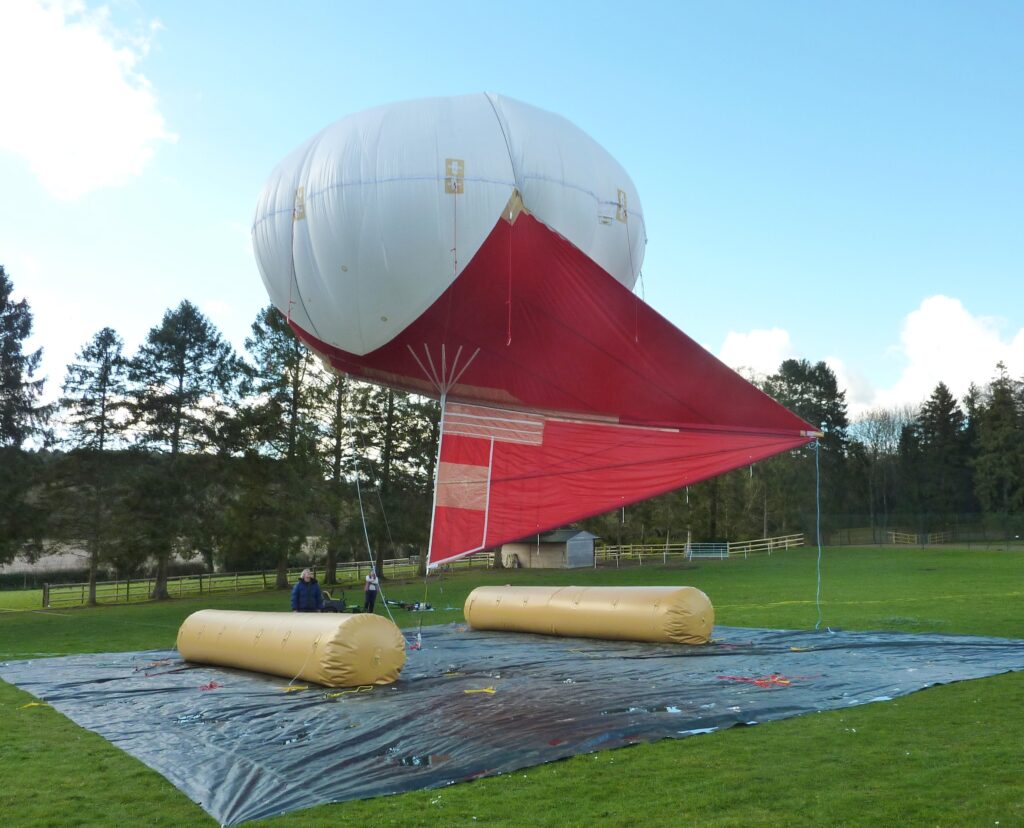In 2018, Eberhard Bodenschatz of the Max Planck Institute approached UK-based kite-balloon manufacturer Allsopp Helikites with an ambitious plan to further understand the impact of cloud cover on climate change.
The project would involve installing a 70Kg laser cloud droplet monitor on a 250m3 Desert Star Helikite and then, within a huge fleet of research ships, tow it twice across the Atlantic, at more than 5,000ft through the hugely influential maritime clouds.
This was to be a critical part of the massive €3m EUREC4A science project, that sent a fleet of vessels and aircraft across the Atlantic and back, to understand the internal workings of maritime clouds and the couplings between clouds, circulation and convection. The project impressed upon Allsopp the importance of clouds in regulating the climate and why climate models are far less accurate without a microscopic understanding of cloud formation.
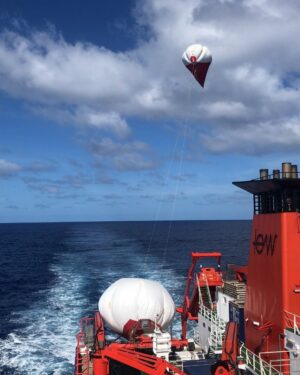
Understanding the formation of cloud droplets requires gentle, microscopic study with the clouds being undisturbed by rotor wash or movement of the instruments within the cloud. This is impossible with manned aircraft, UAVs, free floating balloons or parachute sondes because they cause too much disturbance moving rapidly sideways or vertically through the clouds. Also, as the laser droplet measuring devices are exceptionally expensive and rare, they need to be attached to a reliable device that will not fail or go missing.
As the Desert Star Helikite uses both wind and helium to provide lift, it is both exceedingly stable and reliable in high winds, while also being lighter than air thus enabling it to fly when there is no wind. According to Allsopp Helikite, no other tethered aerostats are as easy to fly from ships as Helikites and none of similar size can reach the high altitudes required.
Desert Star Helikite system
Previously, the largest Helikite made had by the company had been 100m3, so a design and works program was instigated that resulted in a 175m3 and a 250m3 Desert Star Helikite being produced.
The company also designed and produced its new ‘Extra Large V8 Gasoline Helikite Winch’ to deal with the 7,500ft of tether cable required and the 2-ton tether strain. The new Helikites also needed a system for coping with the large air pressure differences encountered and a ground handling system that was safe and effective at sea in all conditions and operated by only three people.
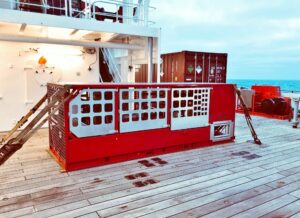
When tested, both Helikite systems proved immediately successful, deploying and flying perfectly in all weathers to the high altitudes required. They were exceedingly stable which was essential for the sensitive laser droplet measuring equipment that was mounted on the Helikite keel. The 175m3 Desert Star Helikite was purchased by the meteorology department of ETH Zurich for flying into clouds from Swiss mountains, and the 250m3 device was sent to Max Planck for the EUREC4A project.
In 2019, the Desert Star Helikite was put into action, flying high into the clouds for several weeks, gathering ground-breaking droplet formation data as the EUREC4A fleet traveled from Portugal to Barbados. In 2020, the feat was repeated by the same Helikite, but this time going from Rio to Portugal.
Silver Cloud Helikite for all researchers
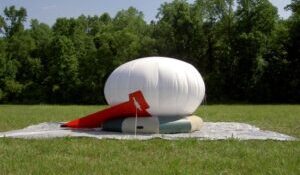
Having realized the importance of cloud research but understanding that most research organizations seldom have large budgets, Allsopp Helikites decided to make a small, economical Helikite that could lift smaller instruments into the clouds.
This resulted in the ‘Silver Cloud Helikite’, a specially designed 16m3 Helikite deployed from a 13ft diameter air-inflated Helibase launch pad, as well as the latest ‘Small Gasoline Helikite Winch’ and tether. This specialist Helikite system will lift lightweight instruments to more than 5,000ft for minimal cost, enabling any researcher to touch the clouds and make new discoveries in a way never before possible.
Clouds, climate change and Helikites
Not only do clouds have an obvious effect on weather, but they also contribute massively to climate change models. The lack of understanding around the exact make up of clouds and how they form causes inaccuracies within these computer models and thus limits the ability to predict the climate.
There are huge differences in opinion as to whether increasing temperatures will create positive feedback by reducing cloud cover thus potentially causing a runaway global warming catastrophe, or negative feedback by increasing cloud cover to cool the globe and retain stable temperatures. There is even disagreement about whether more cloud cools the Earth or warms it.
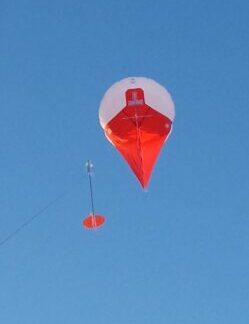
Much depends upon the actual makeup of the water and ice crystals within clouds. Recent work using Helikites and other aircraft carrying sensitive droplet measuring instruments into clouds over the South Atlantic showed that the actual proportion of ice crystals and water droplets was closer to the previous school of thought, that it would create positive feedback. As these types of low cloud are the most common on Earth, this information is vital.
There is interest in the new theory that soluble droplet precursors form small droplets that cause misty cooling clouds, but insoluble droplet precursors cause large droplets that allow infrared rays through to increase warming. Without physically entering the clouds to investigate these concepts firsthand, we can have little idea what is happening.
We also have only a vague idea of how other things affect cloud formation such as pollution particles, oceanic algae, desert dust and smoke from forest fires.
Remote cloud monitoring from the ground or satellite is unable to provide useful data on these fundamental cloud properties. It is only possible to understand clouds by flying instruments within them for long periods of time in a way that does not disturb the delicate, microscopic, cloud droplet and ice crystal formations being measured.
How can droplet formation be monitored in real time?
The problem with attempting to monitor droplet formation with normal aircraft is that they are necessarily traveling at great speeds. Helicopters and drones also create tremendous propellor wash that creates too much disturbance for reliable measurements. Free weather balloons travel upwards at high speed too.
Existing, lighter-than-air dirigibles are good at this work but are few in number, extremely expensive to operate, only fly in fine weather and cannot go very far – such as across oceans. Kites can seldom get to the 5,000ft altitudes required and tethered balloons are too large and expensive, or fair-weather only. According to Allsopp Helikites, the Helikite aerostat is only one type of aircraft that can reliably enter clouds without disturbing them, in most weathers and for low cost.
To learn more about the latest aerostat technology from Allsopp Helikites, click here or email info@helikites.com.
